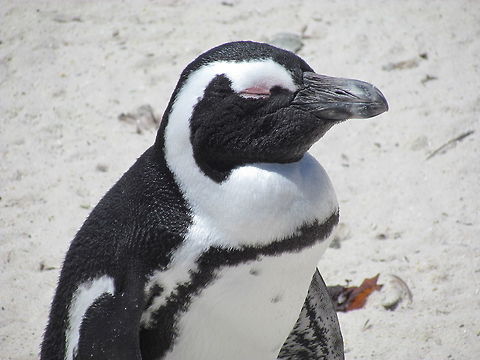
Appearance
African Penguins grow to 68–70 cm tall and weigh between 2 and 5 kg. They have a black stripe and black spots on the chest, the pattern of spots being unique for every penguin, like human fingerprints. They have pink glands above their eyes, which are used for thermoregulation. The hotter the penguin gets, the more blood is sent to these glands so it may be cooled by the surrounding air, thus making the glands more pink. This species exhibits slight sexual dimorphism: the males are larger than the females and have larger beaks. The beak is more pointed than that of the Humboldt. Their distinctive black and white colouring is a vital form of camouflage called countershading– white for underwater predators looking upwards and black for predators looking down onto the dark water.
Naming
The genus to which the African Penguin belongs to, "Spheniscus", derives from the Ancient Greek word "sphen", which means "wedge". This refers to their streamlined body shape. Its species name, "demersus", is a Latin word for "plunging".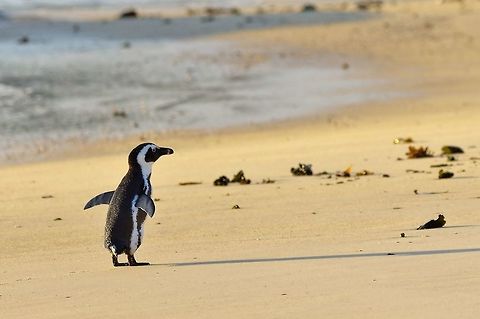
Distribution
The African Penguin is found on the south-western coast of Africa, living in colonies on 24 islands between Namibia and Algoa Bay, near Port Elizabeth, South Africa. It is the only penguin species that breeds in Africa and its presence gave name to the Penguin Islands.Two colonies were established by penguins in the 1980s on the mainland near Cape Town, namely Boulders Beach near Simon's Town and Stony Point in Betty's Bay. Mainland colonies probably only became possible in recent times due to the reduction of predator numbers, although the Betty's Bay colony has been attacked by leopards. The only other mainland colony is in Namibia, but it is not known when this was established.
Boulders Beach is a tourist attraction, for the beach, swimming and the penguins. The penguins will allow people to approach them as close as a metre.
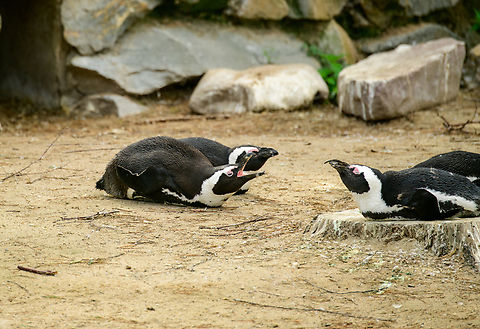
Status
The African Penguin is one of the species to which the "Agreement on the Conservation of African–Eurasian Migratory Waterbirds" applies. The African Penguin is listed in the Red Data Book as an endangered species.In September 2010, the African Penguin was listed as endangered under the U.S.A Endangered Species Act.
Roughly 4 million penguins existed at the beginning of the last century. The total population fell to 200,000 in the year 2000; ten years later, in 2010, the number was estimated to be only at 55,000. If this decline is not halted, the African Penguin is expected to be extinct within 15 years.
5,000 breeding pairs were estimated to live in Namibia in 2008; in 2009, about 21,000 pairs were estimated to live in South Africa.
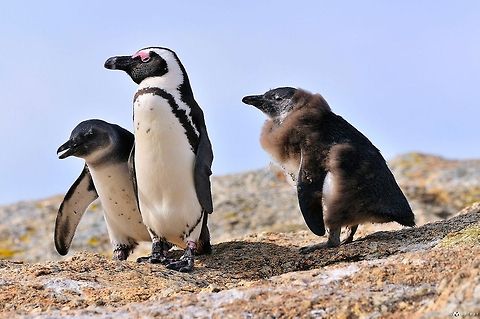
Reproduction
The African Penguin is monogamous. It breeds in colonies, and pairs return to the same site each year. The African Penguin has an extended breeding season, with nesting usually peaking from March to May in South Africa, and November and December in Namibia. A clutch of two eggs are laid either in burrows dug in guano, or scrapes in the sand under boulders or bushes. Incubation is undertaken equally by both parents for about 40 days. At least one parent guards the chicks until about 30 days, whereafter the chick joins a creche with other chicks, and both parents head out to sea to forage each day.Chicks fledge at 60 to 130 days, the timing depending on environmental factors such as quality and availability of food. The fledged chick then go to sea on their own and return to their natal colony after a lengthy time period of 12-22 months to molt into adult plumage.
When penguins molt, they are unable to forage as their new feathers are not waterproof yet; therefore they fast over the entire molting period, which in African Penguins takes about 20 days.
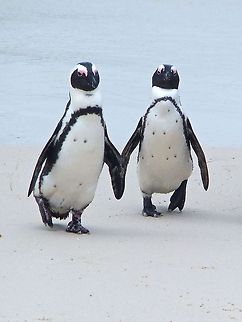
Food
African Penguins forage in the open sea, where they pursue pelagic fish such as pilchards and anchovies, and marine invertebrates such as squid and small crustaceans. A penguin may consume up to 540 grams of prey every day, but this may increase to over 1 kg when raising older chicks.
Predators
Of the 1.5-million African Penguin population estimated in 1910, only some 10% remained at the end of the 20th-century. African penguin populations, which breed in Namibia and South Africa, have declined by 95 percent since preindustrial times.Commercial fisheries have forced these penguins to search for prey farther off shore, as well as making them eat less nutritious prey, since their preferred prey has become scarce. Global climate change is also affecting these penguins' prey abundance.
As recently as the mid-twentieth century, penguin eggs were considered a delicacy and were still being collected for sale. Unfortunately, the practice was to smash eggs found a few days prior to gathering, to ensure that only fresh ones were sold. This added to the drastic decline of the penguin population around the Cape coast, a decline which was hastened by the removal of guano from islands for use as fertilizer, eliminating the burrowing material used by penguins. Penguins remain susceptible to pollution of their habitat by petrochemicals from spills, shipwrecks and cleaning of tankers while at sea.
Disaster struck on 23 June 2000, when the iron ore tanker MV Treasure sank between Robben Island and Dassen Island, South Africa. It released 1,300 tons of fuel oil, causing an unprecedented coastal bird crisis, oiling 19,000 adult penguins at the height of the best breeding season on record for this vulnerable species. The oiled birds were brought to an abandoned train repair warehouse in Cape Town to be cared for. An additional 19,500 un-oiled penguins were removed from Dassen Island and other areas before they became oiled, and were released about 800 kilometres east of Cape Town, near Port Elizabeth. This gave workers enough time to clean up the oiled waters and shores before the birds could complete their long swim home. Some of the penguins were named and radio-tracked as they swam back to their breeding grounds. Tens of thousands of volunteers descended upon Cape Town to help with the rescue and rehabilitation process, which was overseen by IFAW and the South African Foundation for the Conservation of Coastal Birds, and took more than three months to complete. This was the largest animal rescue event in history; more than 91% of the penguins were successfully rehabilitated and released - an amazing feat that could not have been accomplished without such a tremendous international response.
References:
Some text fragments are auto parsed from Wikipedia.